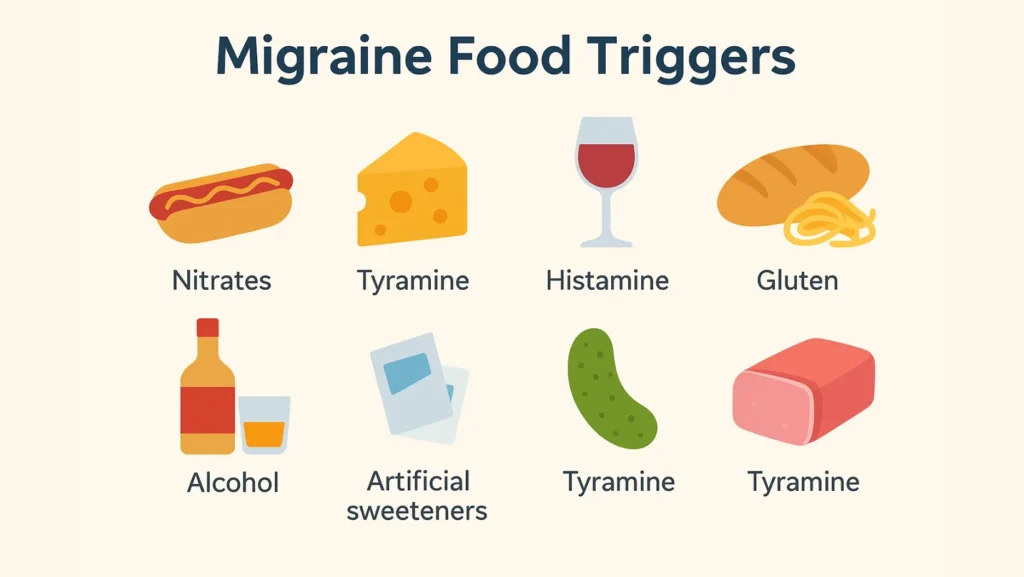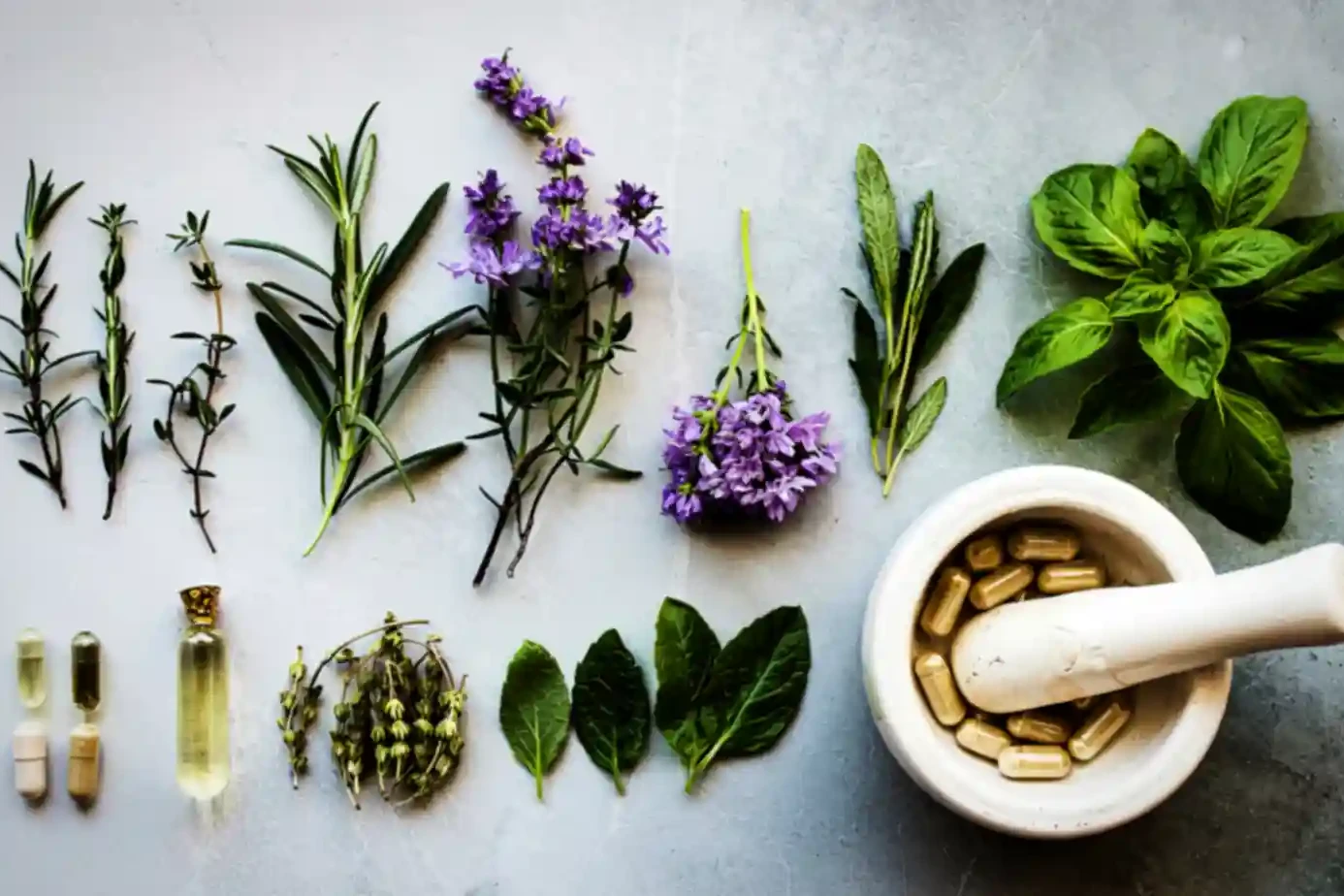Foods to prevent migraines play a big role in how often attacks happen. The right meals give your brain steady fuel and lower the chance of sudden pain. Along with food, simple drinks for migraine relief keep you hydrated and balanced. This guide explains what to eat, what to avoid, and how to build a smart diet for migraines.
Table of Contents
ToggleWhat Foods And Drinks Are Good For Migraine Relief?
When migraine attacks strike, people often ask what to eat during a migraine. The answer is not a single item but a mix of healthy choices. Certain nutrients protect nerves, balance chemicals in the brain, and reduce inflammation. By eating these foods that help prevent migraines, you can cut the risk of frequent pain.
Magnesium-Rich Foods To Prevent Migraines
Low magnesium levels are common in people with Migraine. Magnesium helps relax blood vessels, calm nerve signals, and balance chemicals like serotonin. Adding magnesium foods lowers the risk of sudden attacks.
Best options include:
- Dark leafy greens, avocado, bananas, tuna, salmon, mackerel
- Nuts and seeds such as almonds, pumpkin seeds, and sunflower seeds
- Whole grains like brown rice and quinoa
These foods to eat to prevent migraines also support heart health and digestion. For most adults, 400 mg per day is the goal. A banana with nuts makes a simple snack packed with magnesium.
Omega-3 Fatty Acids And Migraine Prevention
Inflammation in blood vessels plays a role in headaches. Omega-3 fatty acids fight inflammation and improve brain function. Eating oily fish two times per week helps. Plant-based options include chia seeds, flaxseed, and walnuts.
Studies show omega-3s may reduce migraine days in some patients. A fish-based meal plan also supports mood, memory, and sleep. Omega-3s form a core part of a balanced migraine prevention nutrition strategy.
Fiber-Rich Foods For Migraine Management
Sugar spikes can lead to headaches. Fiber / dietary fiber slows sugar release into the blood. This helps keep brain chemicals stable.
Examples include oats, beans, lentils, berries, and whole grain bread. People who eat enough fiber also enjoy better gut health and migraines often improve because a healthy gut lowers inflammation. Adding high-fiber meals reduces cravings for processed food, a known trigger.
Water And Hydration For Migraine Relief
Dehydration is one of the most common causes of sudden headaches. Lack of water makes blood thicker and reduces oxygen supply to the brain. Drinking water regularly is key.
Good hydration and electrolyte balance also helps. Add fruits like watermelon or cucumber to boost water intake. Herbal teas and diluted fruit water count as drinks for migraine relief. Sports drinks may help if sweating heavily, but plain water is usually best.
Whole Foods And Diet For Migraines
Eating whole foods / unprocessed foods gives steady energy without hidden chemicals. Fresh vegetables, fruits, lean meat, and fish are safe choices. Cutting down on processed items reduces risk from additives like MSG and sweeteners.
A diet for migraines based on whole foods keeps blood sugar stable. Pair complex carbs with protein. Add healthy fats like olive oil and avocado. The focus should be balance, not restriction.
What Foods Can Trigger Migraine Attacks?

While some foods protect, others trigger. Triggers vary for each person. A Food journal is the best way to track them.
Common culprits:
- Nitrates / cured meats / hot dogs
- MSG (monosodium glutamate)
- Artificial sweeteners (aspartame, sucralose)
- Alcohol
- Tyramine in aged cheese and smoked foods
- Histamine in wine and pickled foods
- Gluten in bread and pasta for sensitive people
Even Dark chocolate can act as a trigger for some while helping others. Testing foods one by one is key.
Caffeine And Migraine Relief: Helpful Or Harmful?
Caffeine and migraine relief is a double-edged sword. A small cup of coffee or tea can stop early pain. Some headache pills even mix caffeine with painkillers.
But too much caffeine can rebound into daily headaches. Sudden withdrawal also causes pain. Use caffeine in small amounts, not daily. Many people benefit from ginger tea or water instead. Always monitor how caffeine affects you.
How Can You Identify Foods That Trigger Migraines?
Tracking meals is the best way. Keep a Food journal for four weeks. Write what you eat, when pain starts, and how severe it is. Patterns will appear.
A doctor may suggest a migraine elimination diet. This means removing suspect foods for 2–4 weeks. Then you reintroduce them one at a time. This helps find your trigger vs safe foods. Never remove too many foods without medical advice, as that risks poor nutrition.
Table: Trigger vs Safe Foods For Migraine
| Trigger Foods | Safer Options |
| Cured meats with nitrates | Fresh lean meats or fish |
| Aged cheese (tyramine) | Fresh cheese or dairy alternatives |
| Alcohol, especially red wine | Herbal teas, water, coconut water |
| MSG-loaded snacks | Homemade meals with fresh spices |
| Artificial sweeteners | Honey or fruit for natural sweetness |
| Gluten (in sensitive people) | Rice, quinoa, gluten-free oats |
Is There A Specific Diet To Prevent Migraines?
No single plan fits everyone. But some diets show promise:
- Mediterranean diet: Rich in vegetables, fish, olive oil, and nuts.
- DASH diet: Low in sodium, high in fresh produce.
- Plant-based diet / vegan diet: Removes animal triggers, boosts fiber.
- Keto diet / ketogenic diet and Modified Atkins diet: May help by reducing brain over-excitability.
Choosing a migraine diet plan depends on your health. Most people find a simple Mediterranean-style approach sustainable.
About Elimination Diets For Migraine Management
An elimination diet is temporary. It helps find hidden food triggers. The process is slow but effective. Avoid multiple suspect foods for two weeks. Add them back one at a time. Watch for symptoms.
This strategy avoids guesswork. It works best under guidance from a doctor or dietitian. When done right, it reveals which foods that help prevent migraines are safe for you long-term.
Practical Foods And Drinks You Can Try Now
Adding safe foods daily keeps your brain balanced. Simple changes include:
- Leafy greens, bananas, avocados for magnesium
- Salmon, mackerel, tuna for omega-3s
- Nuts and seeds for protein and nuts and seeds for brain health
- Oats, quinoa, brown rice for steady sugar release
- Water and ginger tea for migraine as calming drinks
Other supportive foods include turmeric and inflammation-fighting spices, and dairy alternatives and migraine safety if milk worsens your pain. Together, these build a reliable list of foods that help prevent migraines.
Small meals every 3–4 hours also help. Skipping meals often triggers headaches. Balanced snacks are a natural thing to eat during a migraine solution.
The Bottom Line
Migraine pain often feels out of control, but your plate is one tool you can control. Eating the right foods, drinking the right fluids, and avoiding triggers reduces both severity and frequency. Use your Food journal, make steady changes, and build your personal safe list. The mix of foods to prevent migraines and smart drinks for migraine relief gives long-term benefits for brain and body.
FAQs
What is the best food or drink for migraines?
The best choices include magnesium-rich foods like leafy greens and bananas, plus omega-3 fish. Drinks for migraine relief include water, coconut water, and calming herbal teas.
What drink helps get rid of migraines?
Plain water is most effective. Ginger tea helps nausea. Small caffeine amounts may relieve early pain. Avoid alcohol and soda. Good hydration remains a simple, proven prevention method.
How to heal migraines naturally?
Eat balanced meals. Include magnesium and omega-3 foods. Stay hydrated. Track triggers in a journal. Rest in a quiet, dark place. Gentle exercise and stress control also help reduce migraine.
What stops a migraine fast?
Sip water slowly. Rest in silence. Apply a cold compress. Use ginger tea or small caffeine. If needed, take prescribed medicine. Recognize warning signs early and act quickly.
What fruits reduce migraines?
Bananas, avocados, and berries help balance magnesium and sugar levels. These fruits stabilize blood sugar and support brain chemicals, making them simple, natural options for reducing migraine frequency.
Do bananas help migraines?
Yes, bananas contain magnesium and potassium. These minerals relax blood vessels and steady brain function. Many people find bananas a safe, reliable option in their migraine-friendly food plan.
What drink to avoid in migraine?
Avoid alcohol, especially red wine, because of histamine. Avoid soda with artificial sweeteners. Energy drinks with high caffeine also worsen symptoms. Sticking to water is always the safest option.
About The Author

This article is medically reviewed by Dr. Chandril Chugh, Board-Certified Neurologist, providing expert insights and reliable health information.
Dr. Chandril Chugh is a U.S.-trained neurologist with over a decade of experience. Known for his compassionate care, he specializes in treating neurological conditions such as migraines, epilepsy, and Parkinson’s disease. Dr. Chugh is highly regarded for his patient-centered approach and dedication to providing personalized care.
→ Book a consultation to discover which remedies suit your needs best.






